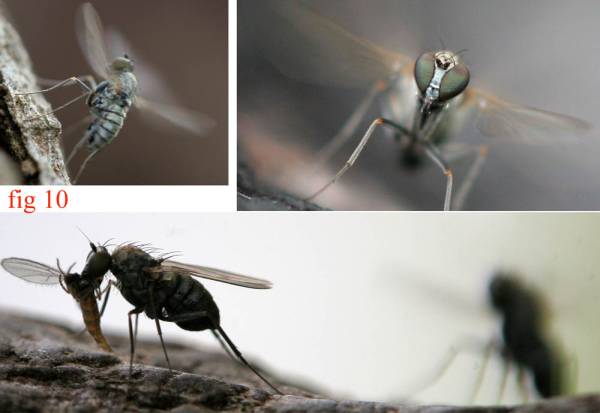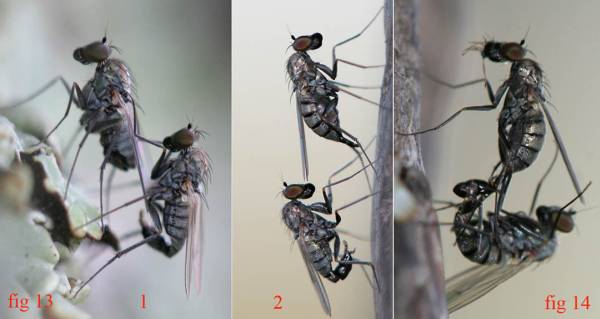| Courtship The first step of courtship is the male's "wing helicoptering". The wing helicoptering point is to the left or right side (+/- 45 degree) of the object of courtship, at a distance of 1-3 cm. Wing helicoptering is not a nessesary step; it was rare in early August and much more frequent in early September. It takes 2-6 sec. |
 |
Then Medetera jumps into blind sector of another Medetera. It is the position for the second step of Medetera's courting. The second step consists of tender stroking of scutellum and wings of the upper fly by one of the forelegs of the lower fly (fig. 11), then less tender stroking done by both forelegs (fig. 12), then mating (or mating attempt) (figs. 13-1, 13-2). |
 |
 |
Copulation is short and takes 10-25 sec. Being aware of mating habits of related Empididae family, I was not very surprised to discover that neither female feeding disturbs male mating, nor male mating disturbs female feeding (fig. 14). As you, of course, noticed there is one problem: the lower Medetera is always a male, but the upper one is in most cases male too! I imagine, that for male far vision, the tree-trunk landscape with the vague silhouette of another Medetera looks like that shown in Figure 15. |
 |
Surely, Medetera recognizes the silhouette of another Medetera, otherwise Medetera is almost invisible on the bark even for more sharp eyes than Medetera's far vision. To prove that I attached small paper "pseudomedetera" to tree surface (fig. 16) and this pseudomedetera was the object of a full courtship program with wing helicoptering and stroking. I also observed natural misrecognizing: a male courting a tree bark tooth once, another time courting a small Medetera pallipes. So, male mating strategy may be formulated as follows: "I'll do my best and I don't much care whether the female refuses mating with me because she is not ready to or because she is a male or because it isn't fly at all." But it still does not explain why the fly in the upper position is male in 8 cases out of 10. I have two guesses. First guess is that males have to do their best to find more silhouettes of other Medetera on the trunk. It does not matter what exactly is being done for best searching (for example, to choose higher points for observation or to change points more often), but searching male itself becomes a better visible silhouette for other males which immediately come to try to mate with him. The second guess is connected with the first one: mating attempt catalyzes reciprocal mating attempt. I observed a comical scene. Male N1 sits on a bark, Male N2 jumps to him in the lower position and begins to stroke him. Being a male with traditional sexual orientation, Male N1 finally jumps out. But after that, Male N1 can see the silhouette of another Medetera (it is Male N2). Male N1 jumps to him in lower position and begin to stroke Male N2... Medetera, these raptors of tree bark, are peaceful towards each other and do not show any territorial behavior. |
 |
||
|
||
 Users Online
Forum Threads
Newest Threads
· Chironomidae > Psect...· Sphaeroceridae ID · Culiseta annulata? -... · Tabanidae, help id, ... · Mycomya species? Hottest Threads
Theme Switcher
Last Seen Users
Latest Photo Additions
|
Observations on Medetera jacula (Fallén, 1823)
Comments
Post Comment
Please Login to Post a Comment.
Ratings
Rating is available to Members only.
Please login or register to vote.
| Date and time
Login
Temporary email?
Due to fact this site has functionality making use of your email address, any registration using a temporary email address will be rejected.
Paul Donate
Latest Articles
· Voltinism in Chaoborus
· Vitaliy Nikolaevich ... · Mating behaviour and... · Oviposition into the... · African Invertebrates Syrph the Net
License Agreement - Click to Download Public files of Syrph the Net can be downloaded HERE Last updated: 25.08.2011 Shoutbox
You must login to post a message. 06.12.25 21:37 He last posted here in April, identifying some Chloropidae.
04.12.25 20:02 Dr Michael von Tschirnhaus, a leading expert on Chloropidae and Agromyzidae, died on 16 September 2025 at the age of 86. He will be greatly missed by the international community. R.I.P.
03.12.25 12:46 Anyone has the scan of "Harkness, R. D.; Ismay, J. W. 1976: A new species of Trachysiphonella (Dipt., Chloropidae) from Greece, associated with an ant Cataglyphis bicolor (F.) (Hym., Formicidae)
01.12.25 22:29 I will try to fix the messages this month. We have to make some other configuration changes before software goes out of support at end of year.
29.11.25 21:57 I would prefer not to receive any more messages from diptera.info signed by Paul... (Thread reply notification)... Could they be signed by ‘The diptera.info team’?
19.11.25 12:31 It is with deepest sadness in my heart that I announce that on Saturday, November 15, one of the great minds of world dipterology, prof. Rudolf Rozkošny, left us forever.
Please remember him with a
15.08.25 10:15 For those specialists not active on Facebook, I just ask to consider to join our group on FB. Please, be aware that it is not necessary at all to be active on FB outside the diptera group. Actually, n
15.08.25 10:13 We received requests to get permission to ask for ID in our Facebook group, https://www.facebo
ok.com/groups/1798 95332035235/ Until now we pointed to diptera.info, but since Paul's passing we not 23.06.25 18:10 If you have some spare money, there is a copy (together with keys to pupae and larvae) for sale by Hermann L. Strack, Loguivy Plougras, France
23.06.25 11:18 Appreciate it, Tony Irwin! I got the hint to use the key next to Langton and Pinder key for females of Chironomidae. So no specific queries, except the keys...
I will keep this on my list and hope th
|
|
images in Diptera Gallery and Forum of their respective owners Powered by PHP-Fusion copyright © 2002 - 2025 by Nick Jones. Released as free software without warranties under GNU Affero GPL v3. SimpleAsThat |
||
| Render time: 0.94 seconds | 252,992,660 unique visits | ||











 one day I hope to contribute with 1 article!
one day I hope to contribute with 1 article!  OR more.
OR more. 